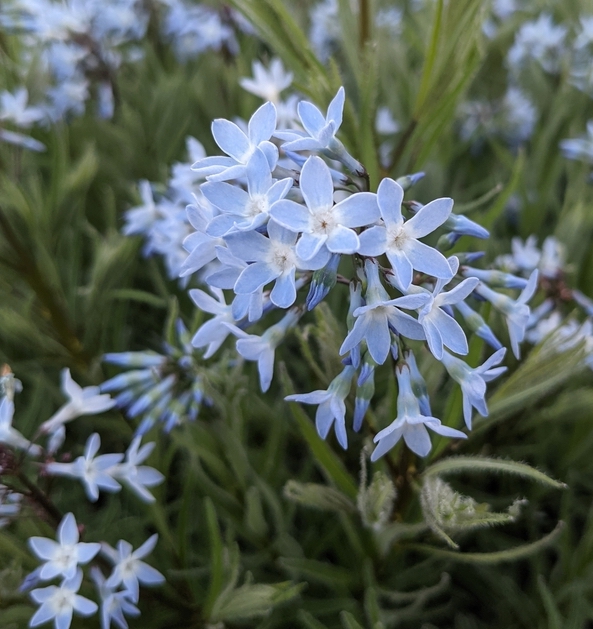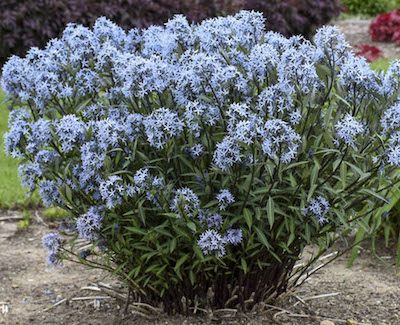Amsonia’s Blue Color Will Persuade You
by Carolyn R. Casey, Fairfax Master Gardener
 Amsonia makes a wonderful addition to your garden particularly if you like the color blue, like I do. It is one of the few truly blue flowers and adds its beautiful blue color to all types of flower gardens.
Amsonia makes a wonderful addition to your garden particularly if you like the color blue, like I do. It is one of the few truly blue flowers and adds its beautiful blue color to all types of flower gardens.
It is a Virginia native but not in Northern Virginia. It is infrequent in the southern Piedmont and inner Coastal Plain from the James River south.
I have Amsonia planted with my Black-eyed Susans, various colors of coneflower and a rose bush as well as several other colorful flowers. It is easy to grow and propagate, attracts pollinators and comes in a variety of cultivars.
Amsonia tabernaemontana has several common names such as Blue Dogbane, Blue Star, Blue Star Flower, Eastern Bluestar and Woodland Bluestar. As of November 26, 2019, Amsonia was not listed on the invasive plant list.
It is a genus of about 20 different species. The genus name is in honor of an 18th century Virginia physician named Dr. Charles Amson. The species is named for 16th century German herbalist Jakobus Theodorus Tabernaemontanus.
Amsonia is an erect clumping perennial that has beautiful and delicate blue star-shaped flowers that bloom in March, April and May as a cluster. Each flower has four to five petals. It has narrow green alternating foliage with a lanceolate and ovate shape that are 3 to 6 inches (7 to 15 cm) long and 1 to 3 inches (3 to 7 cm) wide.

Amsonia in fall
In the fall, the foliage turns a beautiful golden yellow color and then becomes deciduous. Amsonia has fruit that appears in the fall that looks like a green pea pod and is about 3 inches long (7 cm). These pods contain corky cinnamon to brown colored seeds that can be used to propagate the Amsonia plant. It can also be propagated by division, root cuttings and stem cuttings.
Stem cuttings may be taken after flowering for propagation. Propagation by seed needs a stratification process, and the seeds will take 10 weeks to sprout. The seedlings will not be ready to transplant for 20 weeks. When propagating from seed, your plant will not bloom until the second year. Deadheading Amsonia prevents it from self-seeding.
The stratification process is when a seed is exposed to moist, cold or warm conditions to break dormancy. Flowers that produce seed in the fall undergo stratification naturally when exposed to a cold and wet winter. Propagation by division is easy and needs to be done in the late summer or early fall so that the plants have a chance to develop deep roots prior to the ground freezing. When propagating by division, make sure that each division includes at least one eye. Cover newly divided plants with winter mulch to keep them from heaving during freeze and thaw periods.
Amsonia is easy to grow and does not require a lot of care. It can grow in clay, silt and sandy soils with a pH that is neutral between 6.0 to 8.0. It prefers well-drained and moist soils and is also drought tolerant. Amsonia is best suited to zones 3 to 9. It likes full sun of up to six hours or more a day. It can also grow in part shade with two to six hours of sunlight a day. Amsonia grows 2 to 3 feet (0.5 to 1 m) tall and 2 to 3 feet (0.5 to 1 m) wide. It may need to be staked due to its height and to keep it from flopping over.
When planting Amsonia, place the crown at the soil level and slowly and deeply water the roots and the area around it. Keep the plant moist until it becomes established, and then water the roots when the soil is dry and during droughts. Spread 3 inches (7 cm) of mulch around the plant keeping it away from the stems. To create a bushy and rounded look, cut the stems back one-half to one-third after it has flowered.
Amsonia cultivars
Amsonia tabernaemontana, “Short Stack” is a dwarf cultivar that grows 10 to 12 inches (25 to 30 cm) tall and 18 inches wide (45 cm). It has sky-blue flowers and may be prone to rust.

‘Storm Cloud’
Amsonia tabernaemontana, “Storm Cloud” has blackish stems and in the spring has silver veined dark green leaves that become olive green by summer. It has periwinkle blue flowers that bloom in the late spring to early summer. It may rebloom later and may be prone to rust.
Amsonia “Blue Ice” looks a lot like Amsonia tabernaemontana, but it is compact. It grows 1-1/2 feet (50 cm) tall and wide. It has flowers that are a dark lavender blue and was awarded a 4-star rating from the Chicago Botanical plant evaluation.
Amsonia “Seaford Skies” is a blue star hybrid (Amsonia Hubrectii X Amsonia tabernaemontana) discovered in a private garden in Seaford, Virginia. It grows 2 to 4 feet (0.5 to 1.2 m) tall and 2 to 3 feet (0.5 to 1 m) wide and may grow 5 feet tall (1.5 m). It has sky blue flowers on top of 36-inch erect stems.
Amsonia ciliata is called blue star, fringed blue star or downy amsonia. It is a perennial that is native to the southeastern United States. The specific epithet ciliate means hairy margined due to the fringe hairs on new leaves and stems. It has narrow needle-like green leaves and flowers that are pale blue. You may want to cut the stems to 8 to 10 inches (20 to 25 cm) after it flowers.
Amsonia is a valuable wildlife food source and attracts several different pollinators. It attracts hummingbirds, carpenter bees, Hummingbird Moths and several butterflies like the Mourning Cloak (Nymphalis antiopa). It is the larval host for the Coral Hairstreak that feeds on the flower’s nectar.
It is resistant to deer and most pests due to the toxic latex that is released when the stems are cut or broken. This substance may irritate your skin. While the sap is mildly irritating, it is not considered harmful to people. For people that have allergies to latex, it is recommended to wear gloves.
Amsonia is a delightful addition to any yard or garden particularly if you like the color blue. Passersby will be asking just what is that plant that you have growing there. Happy Amsonia gardening.
Resources
Amsonia tabernaemontana: Eastern Blue Star, Angelica Werth, College of Agriculture, Forestry and Life Sciences
Amsonia tabernaemontana, North Carolina Extension Toolbox
Amsonia tabernaemontana (Eastern Blue-star), Master Gardeners of Northern Virginia
Amsonia tabernaemontana: Eastern Blue Star, College of Agriculture, Forestry and Life Sciences
Blue in the Sun, Susan Martin, Piedmont Master Gardeners